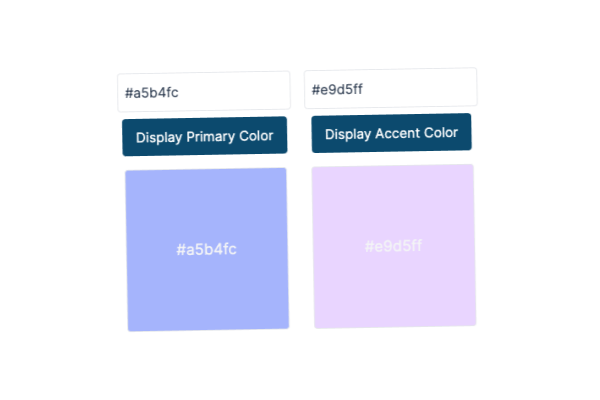How to Customize Background Colors in Tailwind CSS for Brand Consistency
Learn to customize Tailwind CSS background colors with your brand's palette for consistent design.
Maintaining brand consistency across your website is crucial for establishing a strong visual identity.
Tailwind CSS offers a flexible way to customize your project's colors to match your brand guidelines. In this guide, we'll walk you through adding brand-specific colors to Tailwind's color palette and applying them as background colors in your project. We'll also share best practices to ensure consistency across different sections and elements of your site.
Why Customize Tailwind's Color Palette?

Tailwind CSS comes with a default set of colors that are great for rapid development. However, using your brand's specific colors helps in:
Strengthening Brand Identity: Consistent use of brand colors enhances recognition.
Improving Design Consistency: Custom colors ensure that all components align with your branding.
Simplifying Maintenance: Centralizing color definitions makes updates easier.
Setting Up a Custom Color Palette
To customize the color palette in Tailwind CSS, you'll need to modify the tailwind.config.js file in your project. Here's how to do it step by step.
1. Locate the tailwind.config.js File
This configuration file is typically found in the root directory of your project. If it doesn't exist, you can create one using the following command:
npx tailwindcss init2. Extend the Default Theme
To add your custom colors without overwriting the default colors, use the extend key within the theme object. This way, you keep all the existing Tailwind utility classes while adding your own.
// tailwind.config.js
module.exports = {
theme: {
extend: {
colors: {
// Your brand colors go here
},
},
},
plugins: [],
}3. Define Your Brand Colors
Add your brand-specific colors inside the colors object. You can name them semantically for clarity.
// tailwind.config.js
module.exports = {
theme: {
extend: {
colors: {
brandPrimary: '#1A73E8',
brandSecondary: '#FFA726',
brandAccent: '#8E24AA',
},
},
},
plugins: [],
}4. Use Your Custom Colors in CSS Classes
With your colors defined, you can now use them in your HTML or JSX files as utility classes.
<div class="bg-brandPrimary text-white p-4">
This div has a custom brand primary background color.
</div>5. Generate Color Shades (Optional)
If you need different shades of your brand colors, you can define them using a nested object.
// tailwind.config.js
module.exports = {
theme: {
extend: {
colors: {
brandPrimary: {
DEFAULT: '#1A73E8',
light: '#64B5F6',
dark: '#0D47A1',
},
},
},
},
plugins: [],
}Now you can use bg-brandPrimary-light or bg-brandPrimary-dark in your classes.
Best Practices for Maintaining Brand Consistency
Use Semantic Naming: Name your colors based on their function (e.g.,
brandPrimary,brandSecondary) rather than their appearance. This makes it easier to update colors without changing class names.Define a Limited Color Palette: Stick to a set number of colors to avoid inconsistency. Too many shades can dilute your brand identity.
Utilize CSS Variables: If you're working with multiple themes or need dynamic styling, consider integrating CSS variables for more flexibility.
Document Your Colors: Keep a reference of your color palette within your project or style guide to ensure all team members are aligned.
Consistency Across Components: Apply your custom colors uniformly across similar components to maintain a cohesive look and feel.
Example: Applying Custom Background Colors
Here's how you might apply your custom colors in a project:
<header class="bg-brandPrimary text-white p-6">
<!-- Navigation bar -->
</header>
<section class="bg-brandSecondary text-gray-800 p-8">
<!-- Main content -->
</section>
<footer class="bg-brandAccent text-white p-4">
<!-- Footer content -->
</footer>By consistently using the custom color classes, you ensure that each section aligns with your brand's visual identity.
Common use cases
1. Can I overwrite the default Tailwind colors with my brand colors?
Yes, you can overwrite the default colors by adding your colors directly under the colors key instead of extend. However, this will remove all default color utilities, so it's recommended to use extend unless you want to replace the entire color palette.
// Overwriting default colors
module.exports = {
theme: {
colors: {
// Your brand colors here
},
},
}2. How do I create responsive background colors with custom colors?
Tailwind CSS allows you to apply utility classes responsively using prefixes like sm:, md:, lg:, etc. This works seamlessly with your custom colors.
<div class="bg-brandPrimary sm:bg-brandSecondary md:bg-brandAccent">
<!-- Content -->
</div>3. Is it possible to use opacity with custom background colors?
Yes, you can control the opacity by using the bg-opacity-{amount} utilities or by defining RGBA colors in your config.
<div class="bg-brandPrimary bg-opacity-50">
<!-- Content with 50% opacity background -->
</div>4. How can I use custom colors in custom CSS or SCSS files?
You can use Tailwind's theme() function in your CSS files to access custom colors defined in your tailwind.config.js.
/* styles.css */
.custom-button {
background-color: theme('colors.brandPrimary');
}Conclusion
Customizing background colors in Tailwind CSS to match your brand is a straightforward process that significantly enhances the consistency and professionalism of your website. By updating the tailwind.config.js file and following best practices, you can maintain a strong brand identity across all elements of your project.
FAQ
Do I need to restart the development server after changing tailwind.config.js?
Yes, you should restart your development server to see the changes reflected.
Can I use hexadecimal, RGB, or HSL values for custom colors?
Absolutely, Tailwind accepts colors in hexadecimal, RGB, HSL, and other CSS color formats.

Yucel is a digital product creator and content writer with a knack for full-stack development. He loves blending technical know-how with engaging storytelling to build practical, user-friendly solutions. When he's not coding or writing, you'll likely find him exploring new tech trends or getting inspired by nature.